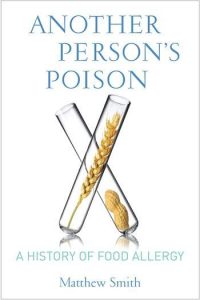I’m currently looking into IBS and its history, for a book I’m writing with dietitian Julie Thompson, and while flicking through a digitised edition of a medical manual from the 1920s – Dr William Osler’s The Principles and Practice of Medicine – I came across this extract on the ‘coeliac affection’.
” …. an intestinal disorder, most common in children between the ages of one and five, characterized by the occurrence of pale, loose stools, not unlike gruel or oatmeal porridge. They are bulky, not watery, yeasty, frothy, and extremely offensive. The affection has received various names, such as diarrhoea alba or diarrhoea chylosa. It is not associated with tuberculosis or other hereditary disease. It begins insidiously and there are progressive wasting, weakness, and pallor. The belly becomes doughy and inelastic. There is often flatulency. Fever is usually absent. The disease is lingering and a fatal termination is common. So far nothing is known of the pathology of the disease.”
 ‘A fatal termination is common.’ Imagine the fear of a parent of a coeliac child a hundred years ago dealing with this, and the helplessness of doctors. I researched and wrote about the history of coeliac disease in the introduction to my previous book – and it was and still is interesting to see how slow but steady the progress made over the last century has been. We are so used to expecting quick answers and rapid solutions that we easily forget that science and medicine takes time – witness the slow piecing together of answers that we’re working through right now with non-coeliac gluten sensitivity.
‘A fatal termination is common.’ Imagine the fear of a parent of a coeliac child a hundred years ago dealing with this, and the helplessness of doctors. I researched and wrote about the history of coeliac disease in the introduction to my previous book – and it was and still is interesting to see how slow but steady the progress made over the last century has been. We are so used to expecting quick answers and rapid solutions that we easily forget that science and medicine takes time – witness the slow piecing together of answers that we’re working through right now with non-coeliac gluten sensitivity.
Anyway, you can read my short introduction on coeliac and gluten history for free on my book’s Amazon Kindle page here (click on the cover image / look inside, then scroll down a fair bit).
And what about the history of food allergy? Again, it’s the last 100 or so years when the key action has taken place. If you want to learn more about it, I would recommend Another Person’s Poison: A History of Food Allergy by Matt Smith.
I was told I couldn't have celiac because it was a "rare childhood disease". Still have doctors reading 90 year old medical texts, it seems.
Interestingly, the US was always a little 'behind' with regard to coeliac, as Alessio Fasano found when he arrived. Also, historically, the Americans denied the role of gluten initially, when the Europeans revealed the cause. Maybe this 'hangover' lasted a while, even among doctors? In some ways, though, US now lead the way – at least, most of the gluten free 'noise' appears to come from America, although it's a mix of good and bad! 🙂
How repulsive and undignifying. Another reason why I don't miss gluten, I don't like the taste or texture of the stuff anymore actually.
Gluten itself has no taste, I think, but the texture's certainly distinctive – it's great that you have reached this stage, and a shame that so many coeliacs still miss it, sadly for them …